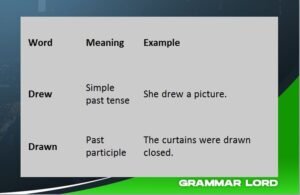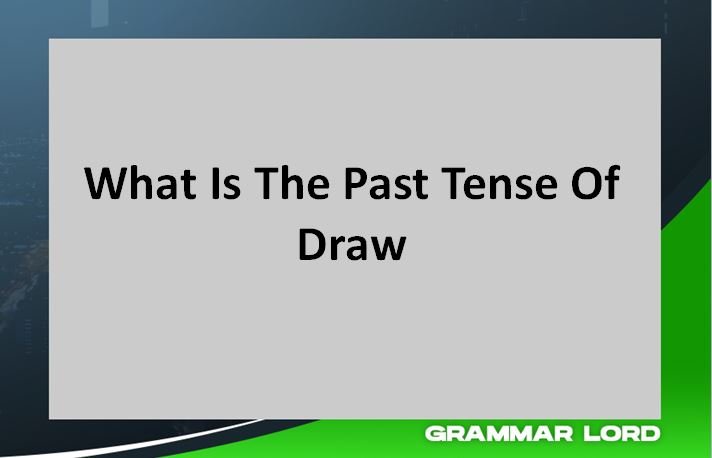The past tense of “draw” is drew. Whether you’re sketching a masterpiece, playing a card game, or participating in a competition, understanding the past tense of this adaptable verb is essential for clear communication. Let’s take a look at the correct usage of “drew” in more detail.
READ ALSO: What Is The Past Tense Of Breed
Contents
How To Use ‘Drew’ In A Sentence?
Even if you’re writing a story, or essay, or simply texting a friend, using the correct verb tense is essential. As we’ve said, “drew” is the past tense of the verb “draw.”
It’s used to describe an action that happened in the past. However, to help you understand how to use “drew” in your writing, here are some examples:
Simple Sentences:
- She drew a beautiful picture of a sunset.
- The artist drew inspiration from nature.
- I drew a deep breath before diving into the pool.
Sentences Showing Past Actions:
- Yesterday, I drew a map to find my way home.
- The detective drew a circle around the suspect’s house.
- The children drew pictures of their families during art class.
Sentences Using ‘Drew’ With Different Meanings:
- The game was drawn, so we had to play a penalty shootout. (meaning: ended in a tie)
- The sword was drawn from its sheath. (meaning: removed from its cover)
- The curtains were drawn closed to block out the light. (meaning: pulled together)
While “drew” is the past tense, “drawn” is the past participle, and It’s usually used with the helping verb “have” (e.g., “I have drawn a picture”).
READ ALSO: Difference Between “Insure and Ensure”
Drew vs. Drawn: Which Is Correct?
Many people get confused about whether to use “drew” or “drawn” in their sentences. While they might sound similar, they have different meanings and uses. Drew is the simple past tense of the verb “draw.” We use it to describe an action that happened in the past.
Example: She drew a beautiful picture.
Drawn is the past participle of “draw, ” which is used with helping verbs like “have,” “has,” or “had.”
Example: The lottery numbers have been drawn.
To help you remember the difference, think of “drew” as an action completed in the past, while “drawn” is more about the result or state of something.

A common mistake is using “drawn” instead of “drew” for past actions. Don’t forget that, “drew” is the correct form for actions completed in the past.
- Incorrect: She drawn a picture.
- Correct: She drew a picture.
Examples Of ‘Drew’ In Different Contexts
Let’s share with you some examples of “drew” in different contexts:
Art And Drawing
- The artist drew inspiration from the vibrant city.
- She carefully drew a detailed sketch of the old house.
- I drew a funny cartoon character for my friends.
Sports And Games
- The soccer player drew a foul on the opposing team.
- The archer drew her bow and released the arrow.
- The contestant drew the number one.
Everyday Life
- I drew a deep breath before giving the presentation.
- The detective drew a circle around the suspect’s house.
- The child drew a picture of their family for Mother’s Day.
Writing And Storytelling
- The author drew on personal experiences for her novel.
- The journalist drew conclusions based on the evidence.
- The poet drew comparisons between love and nature.
Other Verb Tenses Of ‘Draw’
Let’s talk about the different ways you can use the word “draw”. It’s not just about the past tense, “drew”. There are lots of other ways to use it.
Present Tense
We use the present tense to talk about things that happen now or are always true:
- I draw pictures every day.
- Artists draw inspiration from the world around them.
Present Continuous Tense
This tense is for things happening right now:
- She is drawing a beautiful landscape.
- They are drawing lots for the raffle.
Present Perfect Tense
We use this tense for things that started in the past and continue to now, or for things that happened in the past but are still important now:
- I have drawn many pictures since I was a child.
- They have drawn a lot of attention to the problem.
Past Perfect Tense
This tense is for things that happened before another thing in the past:
- I had drawn the picture before she arrived.
- They had drawn up the plans by the time the meeting started.
Future Tense
We use this tense for things that will happen in the future.
- She will draw a portrait for her friend’s birthday.
- They will draw the winner of the lottery tomorrow.
Future Perfect Tense
This tense is for things that will be finished by a certain time in the future.
- I will have drawn all the pictures by the end of the week.
- They will have drawn the conclusions by the time the report is due.

